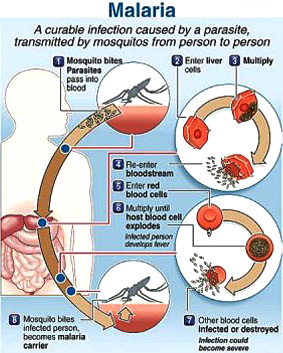Social Justice
Antimalarial Drug Resistance
- 04 Oct 2021
- 4 min read
Why in News
In recent years there is increasing evidence of the Antimalarial Drugs Resistance (AMR) against Malaria.
- It has been noticed while treating with the Drugs (Artemisinin or Chloroquine), either alone or with partner drugs.
Key Points
- Drug Resistance:
- It is simply defined as the ability of disease-causing germs (e.g., bacteria or viruses) to continue multiplying despite the presence of drugs that usually kill them.
- Drug resistance is the reduction in effectiveness of a medication to cure a disease or condition.
- For example: With HIV (Human immunodeficiency virus), drug resistance is caused by mutations in the virus's genetic structure. These mutations lead to changes in certain HIV proteins and enzymes (e.g., protease enzyme) which helps HIV to replicate.
- Factors Causing AMR:
- Mutations:
- The mutations in the malarial parasite have been responsible for artemisinin partial resistance.
- As many as 1,044 studies conducted globally from 2010-2019 confirmed the PfK13 mutation.
- Inadequate Coverage:
- Imperfect coverage of antimalarial drugs, improper diagnosis, misuse of drugs and not-so-good mosquito control programmes were cited by the report as major contributory factors causing resistance against these drugs.
- These failures lead to increased exposure of the malaria parasites to drugs, increasing the risk of drug resistance
- Mutations:
- Concern:
- Chloroquine (CQ) is the most commonly prescribed drug for P Vivax parasite. A World Health Organisation (WHO) report said P vivax resistance to chloroquine had been reported from all WHO regions.
- Twenty-eight countries, including India, showed the CQ resistance.
- A widespread resistance scenario could result in a yearly excess of 22 million treatment failures, 116,000 deaths and costs including an estimated USD 130 million to change treatment policy.
- Chloroquine (CQ) is the most commonly prescribed drug for P Vivax parasite. A World Health Organisation (WHO) report said P vivax resistance to chloroquine had been reported from all WHO regions.
Malaria
- About:
- It is a life threatening mosquito borne blood disease caused by plasmodium parasites, predominantly found in the tropical and subtropical areas of Africa, South America as well as Asia.
- The parasites spread through the bites of infected female Anopheles mosquitoes.
- When an infected mosquito bites a person, the parasite is released into the bloodstream, it then travels to the liver where it matures.
- It is a life threatening mosquito borne blood disease caused by plasmodium parasites, predominantly found in the tropical and subtropical areas of Africa, South America as well as Asia.
- Symptoms:
- Sweating, headache, nausea, vomiting and abdominal pain etc are cited as the symptoms.
- Types:
- Four types of Parasites can infect humans: Plasmodium Vivax, P. ovale, P. malariae and P. falciparum.
- Indian Scenario:
- India carries 2% of the global malaria case burden and 2% of global malaria deaths.
- India also bears 85.2% of the malaria burden in South East Asia.
- India carries 47% of the global P. vivax malaria burden, making the country strategically important for global malaria elimination, particularly in the South-East Asian region, on the other hand India is the only high endemic country which has reported a decline of 17.6% in 2019 as compared to 2018.
- India carries 2% of the global malaria case burden and 2% of global malaria deaths.
- Related Initiatives:
- National Strategic Plan for Malaria Elimination (2017-22).
- National Framework for Malaria Elimination.
Way Forward
- Malaria killed 405,000 people in 2018 and affected 218 million people. However, the fight against this killer is becoming difficult due to the growing resistance against malarial drugs.
- Up-to-date, quality data are needed on the efficacy of the recommended treatments, to ensure that patients receive efficacious treatment.
- The time has come to carry out Molecular Malaria Surveillance to find out the drug-resistant variants so that corrective measures can be undertaken in time to avert any consequences.





